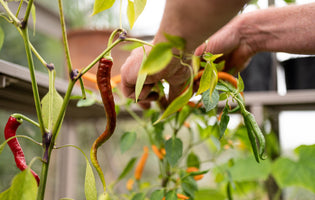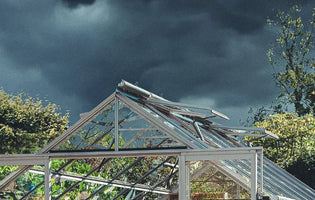Raised garden beds are a fantastic and rewarding way of growing a wide variety of plants, and are especially popular for growing fruit and vegetables. They are a great way of improving drainage and can be used to introduce a different soil type to your garden. There are plenty of reasons why raised beds raise the spirits! There’s also less chance of weeds, more growing space, warmer soil earlier in the season, less soil erosion (especially if the bed is framed), and soil that is basically a neutral pH because you’re filling it (unless you add something to change it).
Another big plus is that raised beds are a convenient way to garden if you have restricted mobility, as they reduce the need to bend. Now, what gardening enthusiast would pass up the opportunity to save their back?
At Rhino Greenhouses Direct, we stock a variety of superb Aluminum Raised Garden Beds. These stunning architectural features are built to last and make an attractive and practical alternative to conventional wooden raised beds.
How to fill raised beds (UK)?
The most inexpensive ways to fill a raised garden bed include using bulk-bought topsoil, homemade compost, sand and recycled cardboard. Plant debris such as landscape fabric, logs and plastic is also very handy when filling up your beds and helping them support your plants' growth. “It's always worth having a good rummage around your garden & garden shed first to see what you can find. There are so many everyday items that can be used to fill up raised beds, helping to reduce the amount of compost you'll need.” suggests Rhino Greenhouses Direct’s Resident Gardening Enthusiast Andrew White.
What soil to use in raised beds?
The best soil type for raised beds depends on what you intend to grow and won’t be the same in all situations. Some plants, such as blueberries, thrive in acidic soil, while others prefer soil with a higher pH.
The weather also plays a role. In a hot, dry climate, you’ll require garden bed soil that retains moisture, but drainage may be an issue in an area with abundant rainfall. A big plus with raised beds is that you are not limited to the soil in the ground. You can start from scratch and build a soil type for raised beds adapted to the kind of plants you want to grow and your region’s unique growing conditions.
Using half topsoil and half organic compost is a good way to start building your raised bed soil mix. Alternatively, you can make a base soil by combining equal parts peat moss, coarse horticultural vermiculite, and good quality organic compost. It’s a bit like being a chef in the kitchen – you have the freedom to experiment. One important component is a balanced, slow-release organic fertilizer.
How deep should a raised bed be?
When building raised beds on top of hard surfaces, it’s best to aim for a depth of at least 20cm but ideally 30cm so plants can root deeply. This will help reduce their watering requirements. Due to improved drainage, plants in raised beds can suffer more from drought – so be sure to watch for this. Another consideration is how high should the raised bed be so that working in it is easy for you.
The minimum required depth depends on the type of plant. On average, a raised garden bed should accommodate about 8 inches of soil for the roots of flowers and vegetables.

What to put on the bottom of a raised bed?
If you are considering building raised garden beds, you should plan to put something underneath. This ensures adequate drainage and simultaneously protects your choice of potting soil mix from the direct heat of the sun as well as weeds.
To avoid poor drainage, use wood chips, newspaper or cardboard, weed-blocking plastic, rubber mulch, landscape fabric or textile cloth, pea gravel (or river stones), burlap sack, coconut fiber, rubber mulch, stainless steel mesh and even pine needles. The best choice for your raised garden bed will depend on the cost and how much time you want to invest in maintaining your raised beds.

Can you use old turf to fill a raised bed?
Yes, you can use old turf to fill a raised garden bed. If you maintain the lawn organically, the grass, roots, and soil will decompose to create nitrogen-rich soil that nourishes the roots of your garden plants. In addition, you won’t have to buy fresh soil or transport the lawn to the landfill.
What flowers to plant in a raised garden bed?
Our experts have found the below flowers are the perfect candidates for planting in a raised bed:
- Daffodils: the quintessential spring stunner, these delightful flowers will grow well in moderate, drained soil with proper moisture. The recommended varieties of Daffodils are Golden Ducat, Petit Four, and Rip van Winkle.
- Lupines: a popular perennial summer flower with gorgeous vivid colors. They’re easy to grow from seed, and there’s no need for fertilizer as they absorb nitrogen directly from the atmosphere.
- Fuschias: these beautiful “dancing ballerinas” are easy to grow from seeds but can also be grown from the tip cutting, where you take the cutting from the more vigorous species.
- Ornamental Onions (gallium): offer a variety of heights, hues, and bloom times, so you can sprinkle a lot of different types throughout your raised beds.
- Lavender: what garden is complete without this exquisite plant with its heady scent? Lavender requires minimal care and is an excellent source of attraction for bees and butterflies. It needs full sun for better growth.
- Begonias: an annual plant in orange, pink, white, and yellow. There are more than 1000 species of begonias!
- Sweet peas: pretty and fragrant; sweet peas need loamy and well-drained soil, regular water, and full sun exposure.
- Morning Glory: open in the morning and closed in the afternoon, they grow rapidly and can aggressively self-seed if not prevented.
- Sunflowers: in most cases, the sunflower will not need fertilizers, and their fast-growing ability will delight you when you grow it in your raised beds.
- Pansies: the best soil for these plants is moist, humus-rich, and well-drained. Stay clear of nitrogen-heavy fertilizer because it can produce more foliage than flowers.
How deep should a raised veg bed be?
The ideal raised bed depth is based on the plants you want to grow. Six inches is the minimum height to grow lettuce greens, herbs, and plants with very shallow root structures. “Not all raised beds are created equal, so before you purchase consider what you'd like to grow & what surface you'll be placing your raised beds on as this may well have an impact on what you can grow.” advises Rhino Greenhouses Direct’s Resident Gardening Enthusiast Andrew White.
- herbs - 6 inches deep
- lettuce - 6 inches deep
- carrots - 12 inches deep
- radishes - 12 inches deep
- peppers - 12 inches deep
- tomatoes - 18 inches deep
- cucumbers - 18 inches deep
- courgettes - 18 inches deep
- kale - 18 inches deep
Should raised beds be in the full sun?
First, determine what you’ll grow: perennials, veggies or flowers? Different plants have different lighting requirements, and your crop plan will influence your raised bed location. Many popular flowers and vegetables prefer full sun, so be sure to locate your raised bed where it will get full sun or at least six hours of direct sunlight a day. A good tip is to observe your growing area for a full year before you commit to placing your bed.

Do you need topsoil in a raised bed?
A 2:1 mix of compost and topsoil soil makes great raised bed soil. If you're buying bags to fill the beds, aim for a mix of 2 parts topsoil with 1 part compost. If you're using soil from your garden or your beds already have soil, add 4 to 6 inches (10 to 15 cm) of compost. Then, till them together until the soil is mixed. Choose loamy topsoil, which means it's loose and not very compact. This allows water to drain and prevents the soil from compacting.
Should I put compost in my raised bed?
Compost is a vital ingredient for any raised bed. It ensures plants access the appropriate quantity and type of nutrients to encourage healthy growth and fruiting. Make sure to use a quality compost.
Can you put a raised bed directly on grass?
If you’re considering putting a raised bed directly on your grass, you should always put some kind of plastic, newspaper, cardboard, or landscape fiber on your grass before adding soil. If the soil in your raised garden bed is shallow, it might not be able to kill the grass; the grass can grow up through the soil and compete with your plants for water and nutrients.
To prevent this from happening, you can:
- Kill the grass in place before building or placing your raised bed
- Remove the grass before building or placing your raised bed
Raised bed features in gardens add depth and color to your landscape, giving you complete control over your planting area, and are available in many shapes and sizes.







